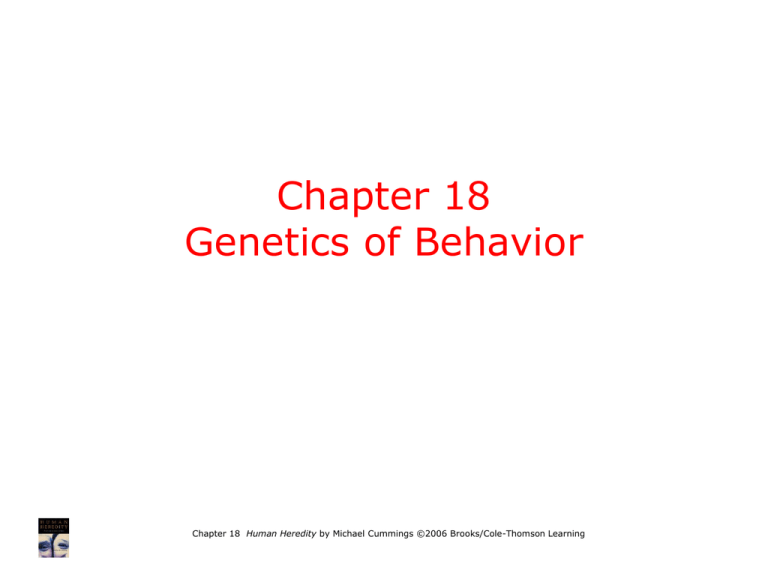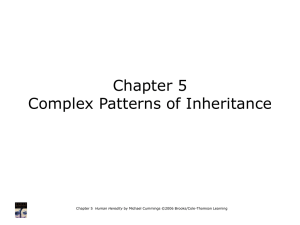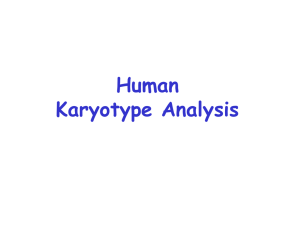
Chapter 18
Genetics of Behavior
Chapter 18 Human Heredity by Michael Cummings ©2006 Brooks/Cole-Thomson Learning
Behavior
• Most human behaviors are polygenic and
have significant environmental influences
• Methods used to study inheritance include
– Classical methods of linkage and pedigree
analysis
– Recombinant DNA analysis
– Combinations of twin studies and
molecular methods
• It is important to refine the definitions of
behavioral phenotypes in order to study the
genetic basis of the behavior
Chapter 18 Human Heredity by Michael Cummings ©2006 Brooks/Cole-Thomson Learning
Models
Chapter 18 Human Heredity by Michael Cummings ©2006 Brooks/Cole-Thomson Learning
Animal Models
• Indicate that behavior is under genetic
control and provide estimates of
heritability
• Molecular basis of single gene effects on
some forms of behavior have been
identified
• Examples
– Open-field behavior in mice
– Narcolepsy
Chapter 18 Human Heredity by Michael Cummings ©2006 Brooks/Cole-Thomson Learning
Narcolepsy
Chapter 18 Human Heredity by Michael Cummings ©2006 Brooks/Cole-Thomson Learning
Mutations in hypocretin receptor (dogs)
Chapter 18 Human Heredity by Michael Cummings ©2006 Brooks/Cole-Thomson Learning
Loss of hypocretin immunostaining in
narcoleptic hypothalamus
Chapter 18 Human Heredity by Michael Cummings ©2006 Brooks/Cole-Thomson Learning
Familial advanced sleep phase syndrome
Jones et al., 1999
Period gene, others?
Chapter 18 Human Heredity by Michael Cummings ©2006 Brooks/Cole-Thomson Learning
Neurodegenerative Diseases
• Are progressive and fatal
• Examples
– Alzheimer disease
– Amyotrophic lateral sclerosis (ALS)
– Parkinson disease
Single genes have been identified for
– Huntington disease
– Spinocerebellar ataxia
Chapter 18 Human Heredity by Michael Cummings ©2006 Brooks/Cole-Thomson Learning
SOD1 Gene
Fig. 18.3
•10% of all ALS cases are inherited as an
autosomal dominant
•Some of these individuals have a mutation
of SOD1 gene
•The mutation causes the SOD1 protein to
become toxic
•Transgenic mice with mutant SOD1 gene
develop muscle weakness similar to humans
Chapter 18 Human Heredity by Michael Cummings ©2006 Brooks/Cole-Thomson Learning
Other Transgenic Studies
• Drosophila studies
• Flies carrying the mutant human
gene for HD and spinocerebellar
ataxia 3
–Demonstrate how mutant proteins
kill nerve cells
–Identify genes or chemicals that
can slow or prevent loss of cells
Chapter 18 Human Heredity by Michael Cummings ©2006 Brooks/Cole-Thomson Learning
Pedigree of KE family
Fig. 18.6
Chapter 18 Human Heredity by Michael Cummings ©2006 Brooks/Cole-Thomson Learning
Language and Brain Development
• SPCH1 region of chromosome 7 involved in
development of speech
• First identified in KE family
• Non-family member with same speech
deficit allowed discovery of FOXP2 gene
• FOXP2 gene encodes for transcription
factors
• Understanding the action of this gene may
assist in treatment of language disorders
and explain evolutionary changes
Chapter 18 Human Heredity by Michael Cummings ©2006 Brooks/Cole-Thomson Learning
Neurotransmitters
Neurotransmitters
transmit the impulse
across the synapse
Chapter 18 Human Heredity by Michael Cummings ©2006 Brooks/Cole-Thomson Learning
Synapse
Fig. 18.8a
Chapter 18 Human Heredity by Michael Cummings ©2006 Brooks/Cole-Thomson Learning
Nerve Impulse Triggers Release of
Neurotransmitter
Fig. 18.8c
Chapter 18 Human Heredity by Michael Cummings ©2006 Brooks/Cole-Thomson Learning
SSRI and MAOI action
http://www.cnsforum.com/content/pictures/imagebank/hirespng/Drug_SSRI_2.png
Chapter 18 Human Heredity by Michael Cummings ©2006 Brooks/Cole-Thomson Learning
Aggressive Behavior and Brain
Metabolism
• Most forms of mental retardation are
genetically complex multifactorial
disorders
• One form of X-linked retardation
associated with aggressive behavior
is linked to abnormal metabolism of
a neurotransmitter
Chapter 18 Human Heredity by Michael Cummings ©2006 Brooks/Cole-Thomson Learning
Mental Retardation, Aggression,
and a Mutation of MAOA Gene
Fig. 18.7
Chapter 18 Human Heredity by Michael Cummings ©2006 Brooks/Cole-Thomson Learning
Mood Disorders and Schizophrenia
• Unipolar disorder is characterized by
prolonged periods of deep depression
• Bipolar disorder is characterized by
mood swings
• Schizophrenia is characterized by
disordered thought processes and
withdrawal from reality
• Common and likely to be caused by
multifactorial inheritance
Chapter 18 Human Heredity by Michael Cummings ©2006 Brooks/Cole-Thomson Learning
Unipolar and Bipolar Disorder
• Unipolar disorder (depression) is most
common and more common in females
• Concordance for bipolar disorder is 60%
for MZ twins and 14% for DZ twins
• Adoption studies indicate genetic factors
• Environmental factors are also
important
• No genes or markers have been
identified
Chapter 18 Human Heredity by Michael Cummings ©2006 Brooks/Cole-Thomson Learning
Frequency of
Bipolar
Disorder in
Families
Fig. 18.9
Chapter 18 Human Heredity by Michael Cummings ©2006 Brooks/Cole-Thomson Learning
Areas with
Genes Possibly
Associated
with Bipolar
Disorder
Fig. 18.10
Chapter 18 Human Heredity by Michael Cummings ©2006 Brooks/Cole-Thomson Learning
Schizophrenia
• 1% of U.S. population
• Genetic and environmental components
• Features of the illness include
– Psychotic symptoms
– Disorders of thought
– Perceptual disorders
– Behavioral changes
– Withdrawal from reality
Chapter 18 Human Heredity by Michael Cummings ©2006 Brooks/Cole-Thomson Learning
PET Scans of Monozygotic Quadruplets
with Varying Degrees of Schizophrenia
Normal
Fig. 18.12
Chapter 18 Human Heredity by Michael Cummings ©2006 Brooks/Cole-Thomson Learning
Schizophrenia Risk
• Concordance for MZ twins is 46% versus
14% for DZ twins
• With a broader definition of phenotype,
concordance for MZ approaches 100%
• Some linkages have been identified but
studies are contested
• Possibly polygenic and associated with
genes involved in nerve cell myelination
Chapter 18 Human Heredity by Michael Cummings ©2006 Brooks/Cole-Thomson Learning
Lifetime Risk
Fig. 18.13
Chapter 18 Human Heredity by Michael Cummings ©2006 Brooks/Cole-Thomson Learning
Genetics and Social Behavior
Genetic control of
• Tourette syndrome
• Alzheimer disease
• Alcoholism
• Sexual orientation
Chapter 18 Human Heredity by Michael Cummings ©2006 Brooks/Cole-Thomson Learning
Tourette Syndrome
• Motor and behavioral disorder
• Family studies indicate genetic
components
• Inheritance involves a major gene, a
number of minor genes, and
environmental contributions
• DNA markers in genetically isolated
populations have been used to identify
regions of importance on chromosome 2p,
8q, 11q, 20q, and 21q
Chapter 18 Human Heredity by Michael Cummings ©2006 Brooks/Cole-Thomson Learning
Genetics of Alzheimer Disease (AD)
Are Complex
• Gene AD1 encoding amyloid beta-protein
is located on long arm of Chromosome 21
• Mutations of AD1 responsible for early
onset AD - autosomal dominant
• ApOE gene - sporadic
• Other genes on chromosome 1, 14, and
possibly others including mitochondrial
DNA
Chapter 18 Human Heredity by Michael Cummings ©2006 Brooks/Cole-Thomson Learning
Environmental Factors in AD
• Factors that increase the rate of the
disease
– Free radicals production
– Calcium uptake
– Beta amyloid toxicity to nerve cells
• Intellectually stimulating jobs, moderate
exercise, diets low in cholesterol, and
saturated fats may help decrease risk of
AD
Chapter 18 Human Heredity by Michael Cummings ©2006 Brooks/Cole-Thomson Learning
Components of Alcoholism
• Two components of excessive alcohol
consumption
– Damage to nervous system and other
organs results in altered behavior,
hallucinations, and loss of memory
– Behavior patterns that lead to alcohol
abuse and loss of ability to function
Chapter 18 Human Heredity by Michael Cummings ©2006 Brooks/Cole-Thomson Learning
Genetics of Alcoholism
• Alcohol preference can be selected for in
mice
• 25–50% risk of alcoholism in sons and
brothers of an alcoholic family member
• 55% concordance in MZ twins and 28%
concordance of same sex DZ twins
• Adopted sons show rate of alcoholism
closer to their biological fathers
• No genes have been identified; is
probably multifactorial (DRD2 - A1?)
Chapter 18 Human Heredity by Michael Cummings ©2006 Brooks/Cole-Thomson Learning
Sexual Orientation
• Studies suggest a genetic component
• One study suggests
– Concordance for homosexuality in
males is 52% for MZ twins, 22% for DZ
twins, and 11% for adopted unrelated
siblings
– Heritability between 31–74%
• Another study in women
– Heritability 27–76%
Chapter 18 Human Heredity by Michael Cummings ©2006 Brooks/Cole-Thomson Learning
Genes for Sexual Orientation?
• Genes in Xq28
region possibly
associated with
homosexual
behavior??
Fig 18.17
Fig. 18.17
Chapter 18 Human Heredity by Michael Cummings ©2006 Brooks/Cole-Thomson Learning
Current Status
• Evidence for genetic control of complex
behaviors is indirect
• Some progress and possible linkages have
been found on some chromosomes
• At present no genes have been discovered
• Human Genome Project, along with other
methods of study, may lead to
identification of genes involved in behavior
Chapter 18 Human Heredity by Michael Cummings ©2006 Brooks/Cole-Thomson Learning












